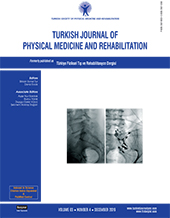The relationship of serum vitamin D receptor levels with disease activity and clinical parameters in patients with ankylosing spondylitis
2 Department of Public Health, Ankara Yıldırım Beyazıt University Faculty of Medicine, Ankara, Turkey
3 Department of Immunology, Ankara University Faculty of Medicine, Ankara, Turkey
4 Department of Immunology, Başkent University İstanbul Health Application and Research Hospital, İstanbul, Turkey
5 Department of Pharmacology, Ankara Yıldırım Beyazıt University Faculty of Medicine, Ankara, Turkey DOI : 10.5606/tftrd.2019.3296 Objectives: The aim of this study was to investigate the relationship between serum vitamin D receptor (SVDR) levels and disease activity parameters in patients with ankylosing spondylitis (AS).
Patients and methods: Between July 2016 and January 2017, a total of 62 patients (51 males, 11 females; mean age 36.5±12.8 years; range, 23 to 49 years) with AS and 32 healthy volunteers (25 males, 7 females; mean age 41.57±13.6 years; range, 26 to 48 years) were included in the study. The SVDR levels were measured using the enzyme-linked immunosorbent assay. Erythrocyte sedimentation rate (ESR) and serum C-reactive protein (CRP) levels were recorded. The Bath Ankylosing Spondylitis Disease Activity Index (BASDAI) scores were used to assess disease activity.
Results: Although there was no significant difference between the patient and control groups (p=0.66), SVDR levels were significantly elevated in patients with active AS (BASDAI score ≥4) (p=0.01). The SVDR levels significantly increased in AS patients with peripheral joint involvement and enthesitis (p=0.01, p=0.05, respectively). The SVDR levels significantly elevated in patients treated with non-steroidal antiinflammatory drugs, compared to those treated with biological agents and control group (p=0.01, p=0.03, respectively). The SVDR levels were positively correlated with the BASDAI, CRP and ESR in the patient group (p=0.01, r=0.751; p=0.01, r=0.75; p=0.01, r=0.81, respectively).
Conclusion: Our study results suggest that serum SVDR levels are associated with the disease activity and clinical parameters in patients with AS. Based on these findings, SVDR level may be used as a marker of disease activity in AS.
Keywords : Ankylosing spondylitis, clinical and laboratory parameters, serum vitamin D receptor
















